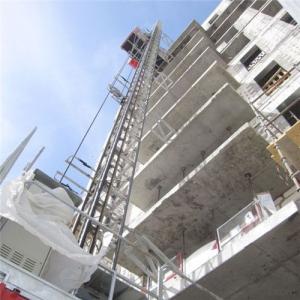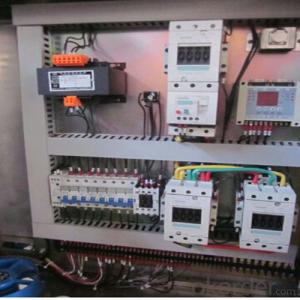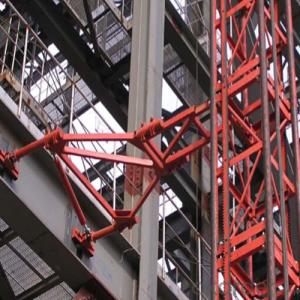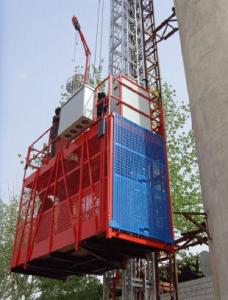Building Hoist SC250 Construction Machine for Sale
- Loading Port:
- China main port
- Payment Terms:
- TT or LC
- Min Order Qty:
- 1 unit
- Supply Capability:
- 30 unit/month
OKorder Service Pledge
OKorder Financial Service
You Might Also Like
Building Hoist SC250 Construction Machine
The hoist adopted with the normal electrical control method, is equipped with contactor, control transformer, anti-overheat protector, relay against the phase failure & disorder. All the electrical parts are equipped with Schneider and Siemens products.
The inverter, as a key controlling part, is used in the hoist adopted with VFD+PLC control method. This device is jointly developed by Japan Yaskawa and us. The hardware is supplied by Yaskawa, while the controlling software is supplied by us ensuring safe & reliable operations. PLC controller adopts OMROM products; brake unit is from YASKAWA and other electrical components are from Schneider or Siemens.
With application of VFD, it’s able to realize stepless speed regulating between zero and max speed. There are two shifting-gears set in the operating platform. One is maintenance shift, which can enable the cage run at speed of 0~5M/min for user to check the lubricating condition and connection of the machine’s parts. The other is working shift, enabling the cage with normal working speed. By adopting this control method, it’s also able to check and show the condition of power supply, operation and electrical failure. Moreover, it can avoid misoperation, giving great protection to transmission & electrical system.
Main Parts of Building Hoist
1. Adopts the most advanced VF speed control device and microcomputer programmable logic controller.
2. Stepless speed control helps eliminate the concussion during start up and braking, steady the operation process, and ensures automated leveling.
3. Adopts open loop V/Fcontrol; the speed control precision can reach ±2~3%. Realizes accurate low speed positioning of the hoist and avoid slipping during downward stopping of hoist.
4. The VF system has current-restriction function, ensuring a small current when motor start up and reducing the concussion to power supply. It reduces the engery consumption and mitigates effects to on site electric equipments.
5. The steadiness during running mitigates concussion to mechanical parts, reduces wears of rack, pinion and the brake and prolongs the spare parts'life.
6. The VF system also has the over voltage protection,low voltage protection, overcurrent, overload and anti-stalling protection functions,
7. The system applies the special software for hoists developed by our company, making the operation more safe and reliable.
Building Hoist images
CMAX Building Hoist

Anchorage System

Driving Unit

Warehouse
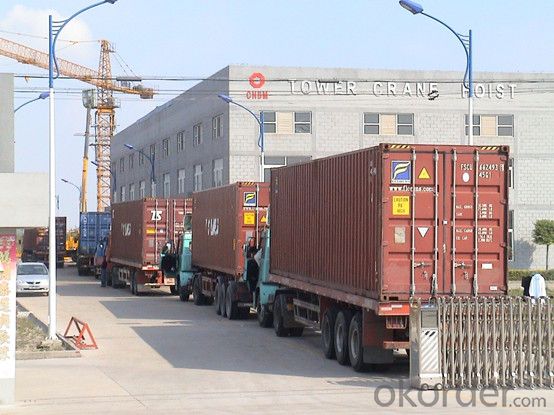
Building Hoist Specifiction

FAQ of Building Hoist
Q: What is the building hoist main purpose?
A: Building hoist equipped with double or single cabin to transport the materials and labors up and down. It's the ideal construction equipment for vertical transportation in the field of construction.
Q: What is the main structure of building hoist?
A: The P/M construction hoist mainly contains metal structure, driving system, electrical control system, cable guide & protection system, electrical top crane and safety device.
Q: What is the meaning of the building hoist’s code?
A: Take SC200/200 for example: “SC” stands for rack and pinion hoist, “200/200” stands for double cage and capacity is 2 tons per cage. “SC200” stands for single cage and capacity is 2 tons.
Q: What is the dimension of the cage?
A: Normally the cage dimension is 3X1.5X2.5M (L/W/H) for 2t type hoist. Details should be checked according to our quotation sheet. Also, the size can be customized according to the factual site condition. There are two doors (entrance & exit doors) for each cage, It can be produced as up & down sliding or ramping model for safety and convenience.
- Q: This question asks for the proper usage guidelines for a building hoist, a mechanical device used in construction to lift materials.
- <p>To use a building hoist correctly, follow these steps: Ensure the hoist is inspected and certified for safe operation. Check all safety devices, including limit switches and emergency stops, are functioning. Securely attach the load to the hoist's hook, ensuring it's balanced and within weight limits. Never exceed the hoist's capacity. Operate the hoist with caution, avoiding sudden starts or stops. Keep the hoist area clear of people and obstacles. Use a tag line to guide the load if necessary. Always lower the hoist when not in use and secure it against wind or other forces. Regular maintenance and inspections are crucial to prevent accidents.</p>
- Q: This question asks for measures to protect lifting equipment from damage during its operation.
- <p>To prevent damage to lifting equipment during operation, ensure regular maintenance and inspection are conducted to check for wear and tear. Adhere to the equipment's load limits and never exceed them. Use appropriate lifting techniques and ensure the load is balanced. Keep the equipment clean and free from debris. Train operators thoroughly on safe operating procedures. Avoid sudden starts or stops, and ensure all safety features and guards are in place and functioning correctly. Regularly check cables, hooks, and other critical components for any signs of damage. Always follow the manufacturer's guidelines and industry safety standards.</p>
- Q: There are two 18-story buildings under construction and tower cranes.
- In this case, you do not need to install the construction elevator at the main stage. After the main body is finished, install the tower crane, reinstall, mainly for decorate the vertical transport of the stage.
- Q: Is it possible to utilize a building hoist for elevating materials to a significant height for stacking purposes?
- <p>Yes, a building hoist can be used for lifting materials that need to be stacked high. These hoists are specifically designed for construction sites to lift heavy materials vertically to different levels. They are equipped with safety features to ensure materials are lifted and stacked securely and efficiently. However, the height to which materials can be stacked will depend on the hoist's lifting capacity and the specific construction site's requirements. It's crucial to follow the manufacturer's guidelines and safety regulations when operating a building hoist to prevent accidents.</p>
- Q: This question asks for methods to reduce the time a lifting device, such as a building hoist, is not operational and the expenses associated with its upkeep.
- <p>Minimizing downtime and maintenance costs for lifting equipment, including building hoists, involves a combination of proactive measures and regular maintenance. Implement a preventive maintenance schedule to address potential issues before they cause significant downtime. Use high-quality components to reduce the frequency of repairs. Train operators to handle equipment correctly and perform basic troubleshooting. Regularly inspect and lubricate moving parts to prevent wear and tear. Implement a condition monitoring system to detect early signs of malfunction. Finally, keep spare parts readily available to expedite repairs and minimize downtime.</p>
- Q: Is it possible for a building hoist to lift more than one object simultaneously?
- <p>Yes, a building hoist can lift multiple objects at once, provided the combined weight does not exceed the hoist's maximum load capacity. The hoist's design and specifications will dictate how many and what types of objects can be lifted simultaneously. It's crucial to follow the manufacturer's guidelines to ensure safety and prevent damage to the hoist or the objects being lifted.</p>
- Q: Does the new approach builder need a localizer test report
- When the distance of the meter cage is not more than the distance shown in the test, the safety device meets the requirements of the relevant specification. You're talking about a construction elevator that's the kind of gear rack that you don't want to have as long as you want to
- Q: How much cable does the construction elevator 44KVA need?
- 44 kva should choose 16 + 2 * 3 * 6 square cable, 16 of the 30 ℃ safe carrying capacity is 78 a cable Current I = P/U / 1.732 = 44000/380/1.732 is approximately 67A The construction elevator will not only carry the engineering materials but also the higher frequency, the load calculation will be calculated according to the continuous working system. The cable should be used for the YGTZ special cable.
- Q: This question asks about the precautions and safety protocols that should be followed when using lifting equipment in construction projects.
- <p>Safety measures for using lifting equipment in construction work include regular inspections and maintenance of the equipment, ensuring all safety features are in place and functioning correctly. Operators must be trained and certified for the specific type of lifting equipment they are using. Load limits should never be exceeded, and all loads must be secured properly. Safe operating procedures should be followed, such as not lifting loads over people and maintaining a safe distance from power lines. Personal protective equipment (PPE) must be worn by operators and workers in the vicinity. Emergency procedures should be established and communicated to all workers. Regular safety briefings and training sessions should be conducted to keep safety at the forefront of all operations.</p>
- Q: Is it feasible to utilize a building hoist for lifting heavy objects when the ground is not level?
- <p>A building hoist is generally designed for vertical lifting in a stable and level environment. Using it on uneven ground can be hazardous and is not recommended due to the risk of tipping or instability. For lifting heavy objects on uneven ground, it's advisable to use specialized equipment like mobile cranes or all-terrain forklifts that are designed to handle such conditions. Always consult the manufacturer's guidelines and safety regulations before using any lifting equipment.</p>
Send your message to us
Building Hoist SC250 Construction Machine for Sale
- Loading Port:
- China main port
- Payment Terms:
- TT or LC
- Min Order Qty:
- 1 unit
- Supply Capability:
- 30 unit/month
OKorder Service Pledge
OKorder Financial Service
Similar products
Hot products
Hot Searches
Related keywords

